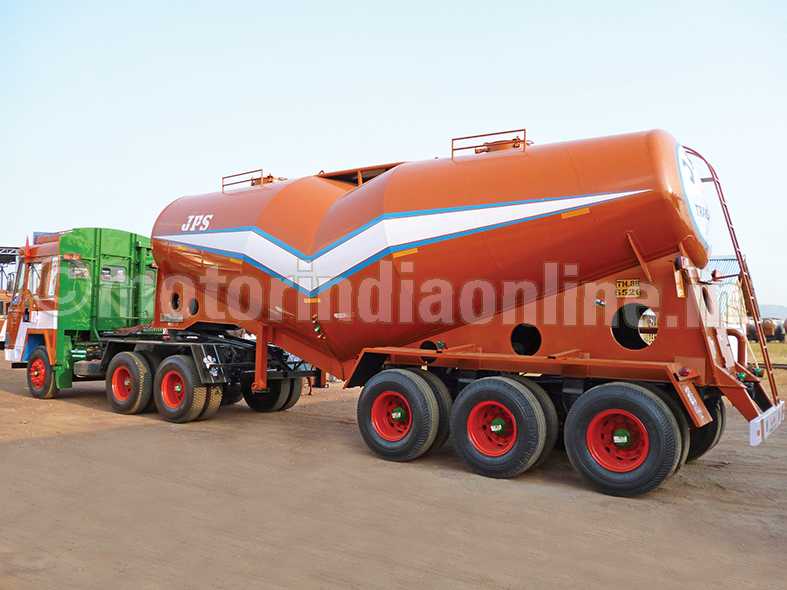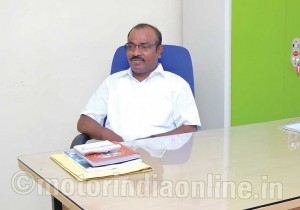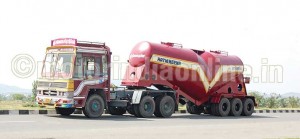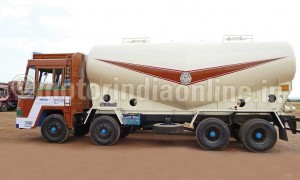Utilising lightweight material to meet domain demands, emerging opportunities and forge ahead
Rows of bulkers in varied eye-catching designs and riot of colours lined up against a verdant and scenic backdrop beckon the visitor to Shree Jaya Durgaa Industries (SJDI), located close to the Karuppattipalayam bypass bordering Namakkal town, T.N. The surprise factor increases as we walk thro’ the cluster of bulkers in various stages of production, assembly and testing, to see nothing but bulkers in the fabrication yard. Such a sight is quite unusual as one is bound to come across allied vehicles like tankers, tippers, trailers and other standard and special body vehicles apart from bulkers in a typical body building company; and especially so in an SSI unit that has commenced its operations in the not-so-distant past.
In the functional works office we meet Mr. Panneerselvam, Director, SJDI, hardcore technocrat with decades of experience in the field and an affable outlook for the interactions. He comes straight to the topic to clear the doubts that SJDI is a specialist bulker manufacturer focussing exclusively on new range/generation bulkers matching up to international standards in catering to the customer demands; and yes, that explains for the monopolistic presence bulkers in the works area. Mr. Panneerselvam indicates that it was also his conscious decision also to veer away from the conventional ‘run of the mill’ mild steel (MS) bulkers, especially with the trend catching up in the segment that lighter the bulker, higher is the payload carrying capacity and profitability for the operator.
Many of the manufacturers involved in the body building and allied segments fall under the unorganised sector and this trend is slowly but definitely changing points out Mr. Panneerselvam. He adds: “The OEMs are developing of new engines, powerful and fuel efficient and incorporating several additional features for an improved performance but the load carrying part/carrier has been left to other manufacturers; and this segment for a long time dominated by body builders in the unorganised segment. This meant that design and engineering are based more on their perceptions and obsolete database invariably leading to increased weights and an overall efficiency drop for a customer investing on the total vehicle say a bulker or a tip trailer. This is where we enter the scene, viz., engineering a lightweight bulker with optimised design for increasing the payload and giving a new meaning to the overall efficiency for the complete vehicle”.
Lightweight bulker
With many of the bulker manufacturers around since late 2000s, how does SJDI fare against the established players in marketplace?; and what are the reasons for their impressive performance? Mr. Panneerselvam explains: “Firstly my background in the design, engineering and maintenance helped; I am an engineering graduate with over 20 years experience in sugar plant maintenance and fabrication of pressure vessels, trailers and bulkers; hence I could start from day one with the product the market wanted. My earlier bulker domain experience in the capacity as a freelance consultant for my friend’s unit gave the exposure to the challenges in the field and the business scope for lightweight bulkers. I started SJDI with the clearly laid out business plan to offer the customers the new range lightweight bulkers fabricated using combination of high strength materials. With the overload regulations becoming more stringent, customers were looking forward to maximising their returns and against this scenario our products appealed to them – that’s the reason for the presence of many bulkers you see in my works yard”.
Illustrating further with examples, he says: “The three phases of concept design, product design and engineering design had not been meticulously followed by body builders in the unorganised segment; understandable so because of lack of knowledge, database, availability of skilled technical personnel and ground reality of cut-throat competition. The bulkers were produced with available standard designs using mild steel (MS) having yield strength of 250 MPa. With overloading regulations not in place/enforced, it was quite common to see bulkers with 50% or more overload carrying cement, fly ash and slag; and encountering myriad problems like higher fuel consumption, increasing tyre wear and maintenance costs and also damage to base carrier. When the overloading regulation implementation was taken up with vigour, the perception of the customers changed – and this was the starting point for the passing load or correct load bulkers”.
He adds: “I realised this trend and before starting SJDI finalised the bulker design using CAD and other application software to cut down the bulker weight as per the loading pattern; to achieve the same various grades of high strength steel (HSS) were considered (in the range between 400 – 1100 MPa) and with an eye on the costs, selection was made for the shell, sub-frame, turning and pipe sections. The use of HSS enables thinner sections to be utilised without compromising on the overall strength and performance expectations. Having frozen the designs, we undertook the modification of 2 nos. bulker for Parasakthi Roadways, Namakkal; and the modified bulker was 25 cu.mtr. capacity on 3118 12 wheel chassis. The bulker tank weight was reduced by 1.3 ton and supplied for the application of cement transport. The performance has been so good that the news about it spread; and the customers started approaching SJDI for getting their heavy MS bulkers modified as lightweight bulkers – for carrying higher payload and yet meet the correct load regulation. Also, recently SJDI has modified bulker trailer cap 43 cu.mtr. on 3518 14 wheel chassis to Sangaiyah roadways, Kumbakonam (well known Rathimeena Travels Group company) reducing the tank weight by 2.1 ton. The customer operating a fleet of over 180 bulkers is more than happy with the performance and planning to change most in his fleet to these lightweight bulkers over a period of time”.
Operations, range and service
SJDI is a small scale unit with a land area of 2.5 acres and connected load of 50 KVA; employs about 20 workers directly apart from 6 admin/technical staff and a contract team of about 30 workers in specialised functional groups to attend to fabrication, under board assembly, painting, electrical, testing, etc. The company has the requisite plant machinery for fabrication and as well for testing the bulkers; and many of the trailer sub-assemblies are sourced from suppliers like York, Fuwa and services from Michelin. The company’s production capacity is about 300 bulkers per annum and they have touched about 50% of it within a short span of 2 years.
“The bulkers are essentially deployed for cement and fly ash transport in south India- the region where our products are in use. In rigid bulkers 2516 10 wheel and 3118 12 wheel are in use; some bulkers are also running on the new model 3718 14 wheel chassis but performance is yet to be ascertained for the applications. The popular model in the rigid classification is 3118 cap 25 cu.mtr. for the correct load application. In the bulker trailer, the popular models include 3518 14 wheel, 4023 18 wheel and 4923 22 wheel; 3518 cap 27 cu.mtr. and 4923 cap 35 cu.mtr. are popular for the cement applications. The bulkers discharge the cement/fly ash at the unloading location silos in about 30 min. Generally 600 cu.mtr/hr. capacity compressor with max 2.5 Kg/sq cm. pressure rating would suffice for most of the bulker combinations”, briefs Mr. Panneerselvam.
The bulker works undertaken by SJDI fall under 4 categories – new supplies, modification jobs, refurbishment and service jobs. Mr. Panneerselvam indicates: “Customer support has been one of our USPs and we give 1 year full warranty for the bulker against manufacturing defects and performance. Many of the times we visit the sites to study the applications and also sort out the customer-side equipment problems like inadequate airflow for cement unloading to malfunctioning of flow control components in the circuit. I can proudly recall a service case of a cement bulker that had met with an accident; the shell portion was damaged and the vehicle with full load cement could not be moved without the cement spillage on road. The customer was frantic for a quick solution and realising the urgency and seriousness of the situation, we rushed to the spot with a team of skilled welders and mechanics. The repairs were carried out at the site within a short period and without the spillage of even 10 kg of cement; and the vehicle moved on”
Market trends
Mr. Pannerselvam opines “Firstly it’s going to be in the increased use of HSS from 400 MPa to 900 MPa to reduce the section thickness (in shell & sub-frame/ support structure). In India we readily get material up to 490 MPa but beyond this, it’s imported. In such a scenario, a combination of MS and HSS need to be judiciously used – it’s an optimisation exercise with strength and weight as variables to give the best price for the application. Reducing the weight is achieved by blanking out material in unnecessary sections using advanced stress analysis software. For dished ends, because of formability factor, MS is best suited and we use 3 mm section; and to weld it with shell 2.5 mm thk HSS, special grade electrodes are used. The CAD produced engineering drgs ensure that the welding joints and profile are smooth to produce an aesthetic finish apart from of course the basic strength requirements.
Secondly the material with lower specific weight like high strength aluminium alloy (about one third the sp.wt. of steel) can be used to reduce weight. In developed countries especially for load bodies, tankers and bulkers, aluminium has replaced steel in a big way; I see this trend also happening in India and we are already working on aluminium sections for the bulker design. The costs now are prohibitively high for a favourable consideration in the bulker production but then with the increasing nos. and volume off take, the equations are likely to change.
Finally with the utility of bulkers getting established, I expect various payload materials like bentonite, atta (wheat flour), grains and granular chemical materials also transported like cement, as in industrialised countries. This implies various types of shell materials like stainless steel, coated sheets, etc., would be required and bulkers need be designed and engineered for that specific application. Such emerging opportunities of new generation bulkers should open up the business potential in a big way for manufacturers like us”.
A significant change taking place apart from the materials and technology has been in the profile of body builders – from worker-turned-owner in the past to engineers of first generation involved in the start-ups or the second generation steering the companies started by their parents. Presence of many quality educational institutions in the region has also played a key role in the above transformation with the new generation professionals bringing in technology to the traditional way of body building and manufacturing; SJDI is definitely one amongst such companies and with the changeover in process, we are going to see a paradigm shift in the domain. The beneficiaries in this progressive development are going to be all connected with the supply chain right from OEMs, equipment manufacturers to customers; and we could be witnessing at last the load carriers linked/integrated to the prime mover matching the ‘class levels’ and delivering the desired overall results in the transportation sector.



